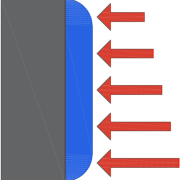Face Pressure Calculator
This computer software is designed to calculate the face support pressure for tunnels excavated by Earth Pressure Balanced Shields (EPBS) which is usually utilized for tunnel construction in urban areas. Deterministic and probabilistic approaches have been used for face pressure assessment.
The software aims to reduce the effects of human error and diminish the result’s uncertainty. Tunnel face support pressure against collapse is calculated using the proposed methods by Jancsecz and Steiner, COB, and a method based on the German standard, DIN 4085. A limit state method is also applied for the surface blowout.
In the deterministic approach, a single value is the output of every method while in the probabilistic approach, required soil parameters such as cohesion, friction angle, and natural and saturated unit weight are simulated 10000 times. The values of face support pressure are proposed by the user to compute factors of safety. Then, they are compared to the predetermined factors of safety to calculate the probability of failure.
References:
1. Jancsecz S. and Steiner, W. (1994). Face support for a large Mix-Shield in heterogeneous ground conditions. In Tunnelling “94: Papers presented at the seventh international symposium, `Tunnelling’94” (pp. 531–550). Springer US. https://doi.org/10.1007/978-1-4615-2646-9_32
2. Guglielmetti, V., Grasso, P., Mahtab, A., & Xu, S. (2009). Mechanized Tunnelling in Urban Areas: Design Methodology and Construction Control. https://doi.org/10.1201/9780203938515
3. Zizka, Z., & Thewes, M. (2016). DAUB Recommendations for Face Support Pressure Calculations for Shield Tunnelling in Soft Ground. https://www.daub-ita.de/en/publikationen/empfehlungen/
4. Deutsches Institut für Normung. (2011). DIN 4085: Subsoil – Calculation of earth pressure.
5. Eshraghi, A., & Zare, S. (2015). Face Stability Evaluation of a TBM-Driven Tunnel in Heterogeneous Soil Using a Probabilistic Approach. International Journal of Geomechanics, 15(6), 4014095. https://doi.org/10.1061/(ASCE)GM.1943-5622.0000452
General Features
The type and number of required parameters depend on the selected calculation approach. In the first step of data acquisition, general features, and the calculation approach are chosen.

General features of the under-study profile
Selection of the calculation approach
Name and type of soil layers from surface to tunnel invert
Deterministic Approach
The required soil parameters of every layer are the main inputs in this approach. The final output is displayed in a new window after the definition of other variables such as partial factors of safety.
General information about the profile, soil layers’ properties, and calculation results are illustrated in the output window.
Probabilistic Approach
The required soil properties are simulated according to real data. The simulation process is performed using the Monte Carlo technique and Box-Muller estimation method. 10000 values are generated for each soil property through the simulation process. There are 5 built-in distribution functions (Burr, Gumble Min, Generalized extreme value, Wakeby, and normal). If the best-fitted distribution function to the real data is one of the above functions, its parameters can be used to generate simulated data. On the other hand, the simulation process can be conducted elsewhere and the results can be loaded from a .txt file. It is also possible to consider a single value for a property in case simulation is impossible.
The simulated data can be stored in a .txt file. The data is saved as four 100×100 line matrices in a column and can be read from the file for other profiles. As a result, the simulation process can be done only once for a whole project.

Selection of density function for simulating layers’ properties
Saving and loading the layers’ properties
A single value instead of a simulation
Definition of distribution function parameters
Predetermined Factors of Safety
10000 values of face support pressure are calculated through the simulation process. The user defines factors of safety against collapse and blow-out. The user also defines the proposed face pressure values to calculate 10000 respective factors of safety. The relative density of generated face pressure values is accessible to help define the face pressure values.
The results indicate the probability of the factor of safety to be smaller than the predetermined values for each predefined face pressure, which can be considered as the probability of failure.
Final Output
A curve representing the probability of failure alongside the profile’s general features is illustrated in the output window. The user can select which method results to be shown in the output.
این مطلب ترجمه شده است به زبان: Persian







